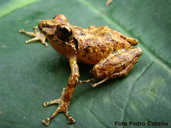|
Pristimantis rivasi Barrio-Amorós, Rojas-Runjaic & Barros, 2010
| family: Strabomantidae genus: Pristimantis |
| Species Description: Barrio-Amoros CL, Rojas-Runjaic F, Barros TR 2010 Two new Pristimantis (Anura: Terrarana: Strabomantidae) from the Sierra de Perija, Venezuela. Zootaxa 2329:1-21. | |
 © 2011 César L. Barrio Amoros (1 of 2) |
|
|
|
Description DIAGNOSIS: Pristimantis rivasi can be distinguished from other members of the genus in its range by the presence of a distinct tympanum and tympanic annulus, fringes on the digits, basal webbing, cranial crests, and a lack of a calcar (Barrio-Amorós et al. 2010) COLORATION: In life, the dorsum is light or creamy brown to whitish, and there is an X-shaped pattern that is ill-defined (but see variation). They have an incomplete black canthal stripe, a poorly defined black interorbital bar, and a black supratympanic stripe. The iris is a bronze-orange coloration with fine, black lines resembling a net like pattern. The dorsal surface of the fore- and hind limbs have transverse marks that can be dark colored to greenish. The ventral surface of the legs are red. The nuptial pad is white (Barrio-Amorós et al. 2010). VARIATION: Variations of dorsal color can range from light brown, creamy brown, to whitish. The contrasting dorsal W, V, or X-shape can be made up of black or brown spots and other marks are dark reddish brown to greenish. Males have vocal slits and a subgular vocal sac. In males, the shapes of the disks on fingers III and IV vary from oval, round, or heart-shaped, but not notched (Barrio-Amorós et al. 2010). Distribution and Habitat Country distribution from AmphibiaWeb's database: Venezuela
The habitat of P. rivasi includes coffee plantations and the understory in premontane and montane forests (Meza-Joya et al. 2016) where they can be found on leaves of various bushes and palms, not exceeding four meters above ground level (Barrio-Amorós et al. 2010). Life History, Abundance, Activity, and Special Behaviors Males are often heard calling in abundance from 1800 - 2000 h, tapering off around 0130 h. Some individuals have also been heard loudly calling after heavy rains in the month of September. Their call can be described as an abundance of rhythmic clicking or ticking sound of, “cloc, cloc, cloc, cloc”, lasting up to a minute in length (Barrio-Amorós et al. 2010). Trends and Threats Possible reasons for amphibian decline General habitat alteration and loss Comments PHYLOGENETIC RELATIONSHIPS: Pristimantis rivasi was placed in the P. unistrigatus species group based on morphology alone (Barrio-Amorós et al. 2010). ETYMOLOGY The species epithet, “rivasi” is in honor of Gilson Rivas Fuenmayor, a herpetologist from Venezuela who is one of the first founders of the species (Barrio-Amorós et al. 2010). OTHER INTERESTING INFORMATION: Research on P. rivasi is limited because the area they inhabit is subject to various types of hazardous occurrences such as drug trafficking, paramilitary groups, and guerrilla warfare (Barrio-Amorós et al. 2010). At the time of the species description, P. rivasi was the largest species from the Pristimantis genus found in the Sierra de Perijá mountain range (Barrio-Amorós et al. 2010).
References
Barrio-Amoros, C. L., Rojas-Runjaic, F, Barros, T. R, (2010). “Two new Pristimantis (Anura: Terrarana: Strabomantidae) from the Sierra de Perijá, Venezuela” Zootaxa 2329, 1–21 [link] IUCN SSC Amphibian Specialist Group. (2020). "Pristimantis rivasi." The IUCN Red List of Threatened Species 2020: e.T194803A109546019. https://dx.doi.org/10.2305/IUCN.UK.2020-2.RLTS.T194803A109546019.en. Accessed on Downloaded on 25 February 2022 Meza-Joya, F. (2016) "First records of two rain frogs, genus Pristimantis (Anura, Craugastoridae), for Colombia." Check List 12(5), 1971. [link] Originally submitted by: Anthony Martinez, Caitlin Bowe, Stacy Bruno (2022-04-12) Description by: Anthony Martinez, Caitlin Bowe, Stacy Bruno (updated 2022-04-12)
Distribution by: Anthony Martinez, Caitlin Bowe, Stacy Bruno (updated 2022-04-12)
Life history by: Anthony Martinez, Caitlin Bowe, Stacy Bruno (updated 2022-04-12)
Trends and threats by: Anthony Martinez, Caitlin Bowe, Stacy Bruno (updated 2022-04-12)
Comments by: Anthony Martinez, Caitlin Bowe, Stacy Bruno (updated 2022-04-12)
Edited by: Ann T. Chang (2022-04-12) Species Account Citation: AmphibiaWeb 2022 Pristimantis rivasi <https://amphibiaweb.org/species/7406> University of California, Berkeley, CA, USA. Accessed Feb 5, 2025.
Feedback or comments about this page.
Citation: AmphibiaWeb. 2025. <https://amphibiaweb.org> University of California, Berkeley, CA, USA. Accessed 5 Feb 2025. AmphibiaWeb's policy on data use. |


 Map of Life
Map of Life